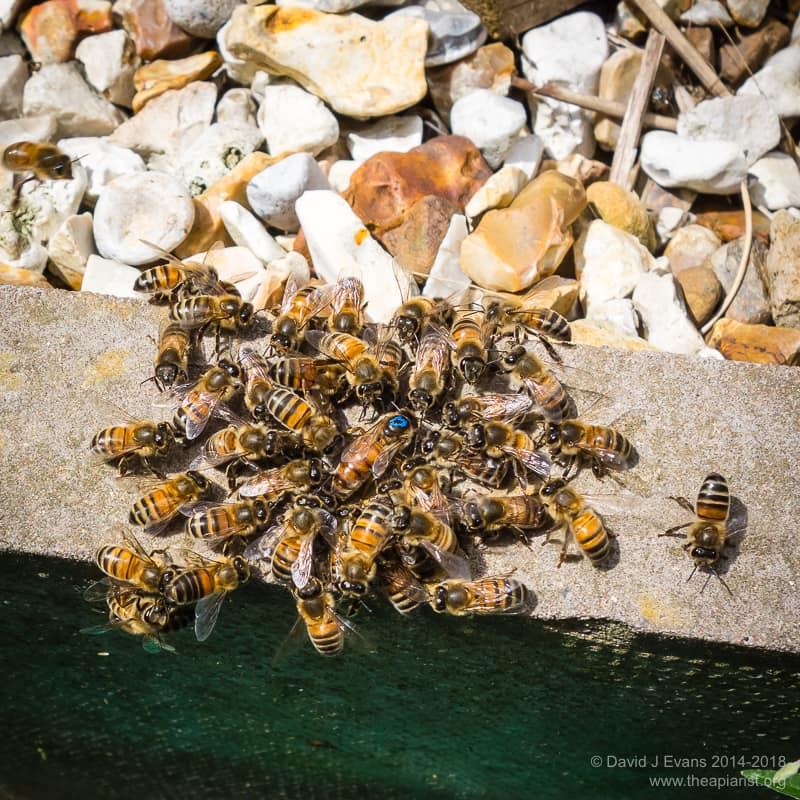Queen clipping - why?
I sometimes have colonies in my (very) small suburban garden … it’s great to be able to watch the bees before leaving for the lab or to observe them early in the season bringing in pollen from the crocuses. It’s also a convenient staging post between my out apiaries and a whole lot easier than carrying heavy boxes around through waist-high field margins. However, I’m aware that my neighbours may not share my enthusiasm for bees. I therefore do my utmost to only keep well-behaved colonies in the garden by selecting for docility as a priority when queen rearing. In addition, I make sure any queens heading colonies in the garden are clipped. Queen clipping is the trimming of one wing, preventing the queen from flying any distance should the colony swarm. In the absence of a queen, a prime swarm leaving the hive will either return to the hive or will cluster with the queen a very short distance from the hive.

Clipped queen …
A colony in the garden swarmed on open queen cells (QC) last Sunday afternoon. The colony had chosen to ignore the super, so filled the brood box with nectar (I suspect I’d added the super too late and the colony had already started to think about swarming). Consequently the colony ran out of space. The QC’s were about 3-4 days old and unsealed. There’d been none present at the previous inspection (remember that colonies usually swarm once the first QC’s are sealed). The colony was half-way through a vertical split (to be described in the future) with the original queen in the top box and the newly emerged virgin in the bottom box. I’d been away and arrived home to find the top box swarming and the air filled with bees. With an unclipped queen they would usually settle in a nearby tree or bush and then send out scouts to find more desirable accommodation.
I might have been fortunate enough to catch this, but they might have settled somewhere inconvenient like the chimney or on the kids trampoline in the garden next door. However, because the queen was clipped, she couldn’t fly and the bees just milled about for 15 minutes … a fantastic sight and sound. Eventually they returned to the hive … but to the bottom box. Shortly after they’d settled I found the queen and a small retinue of workers on the ground about a metre from the hive entrance (see photo above). I quickly went through the top box, shaking bees off the frames and knocked off all the QC’s. I also swapped out a couple of nectar-filled frames for drawn comb. I then ran the queen back into the entrance. With luck the reduced density of bees and increased space to lay will discourage them from swarming again*.
A queen with a clipped wing generally swarms later than an unclipped queen, potentially giving you a few extra days between inspections. However, as the example above shows, you can’t rely on this so seven day intervals between inspections are still recommended. Had I not found the queen she would have probably crawled back to the hive stand, climbed up the leg and ended up under the open mesh floor. Although this is not ideal, it provides another opportunity to recapture her and it’s far preferable to losing the bees altogether or bothering your neighbours with swarms.

Summer storm …
Although the weather was wonderful when the colony swarmed, it rapidly changed later in the afternoon when we were treated to downpour of biblical proportions … any swarm caught out in the torrential rain and hail would have probably fared very badly.

Time to close the hive up …
The image above (the densest cloud formed a wide band from the North East to the South West, almost directly above three of my apiaries) is a composite of three images stitched together in Photoshop. I was desperately trying to get through the last few hive inspections but had to abandon things and seek shelter in the car. The rain and hail didn’t last long, but what it lacked in duration it more than compensated for in volume (both sound and fluid ounces).
Perhaps surprisingly, in the 30 minutes or so before the heavens opened the bees were remarkably well behaved.
* Update on checking six days later (today) the blue marked and clipped queen is back and laying again in the top box. It looks like she’s been getting a lot of attention as the blue paint has almost disappeared. There are no signs of any more queen cells but they’re still not taking much notice of the super. Unfortunately, they are showing signs of robbing another colony in the garden, so I’ll shortly be moving them to another apiary.
In the meantime, I prepared a stack of boxes in preparation of moving house and – within 24 hours – another swarm moved in. I’d missed a finger-wide gap in the stack and the bees occupied a chest-high pile of broods and supers. These look like another generous donation from a neighbour … thank you.
Join the discussion ...